Both types of connectors are able to charge an electric car to 80% in 20 to 40 minutes. Once the battery is charged to this level the chargers output will drop to a slower rate to maximise charging levels and preserve the battery.
The chargers normally feature both connector types which cover the vehicles that are capable of being rapidly charged.
Rapid AC
Rapid AC chargers use a Type 2 charging standard and provide power at up to 43kW.
Type 2 socket and plug
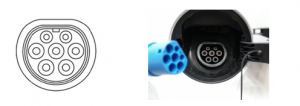
Again rapid AC units are able to charge an electric car to 80% in 20-40 minutes. Once the battery is charged to this level the chargers output will drop to a slower rate to maximise charging levels and preserve the battery.
The AC rapid chargers have tethered cables that plug into the electric car.
Tesla Charging
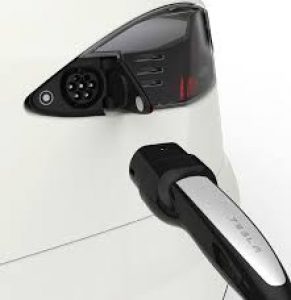
 Tesla has it’s own Supercharger network which are exclusive to Tesla cars. These Supercharger stations provide much higher powered chargers of 120kW for fast charging.
Tesla has it’s own Supercharger network which are exclusive to Tesla cars. These Supercharger stations provide much higher powered chargers of 120kW for fast charging.
The cables are tethered like other rapid chargers and are a Tesla version of the Type 2.
Tesla owners can also buy CHAdeMO adapters so that they can use the 50kW DC Rapid chargers which are more common than the Tesla Superchargers in the UK.
The Tesla fast chargers provide 7, 11 or 22kW but can only be used by Tesla cars, normally with the Tesla type 2 lead sockets. Again the Tesla drivers will need to supply the cable.
Fast Chargers
Fast chargers are rated 7 or 22kW and are AC. A 7kW charger will normally charge your electric vehicle in 3 to 5 hours, a 22kW will take between 1 and 2 hours.
Fast chargers tend to be in public places, supermarkets, shopping centres, railway stations and on the road parking bays.

Type 1
The most common fast charger is a 7kW Type 2 (shown above), in addition, but less frequent there are Type 1 or Commando chargers.
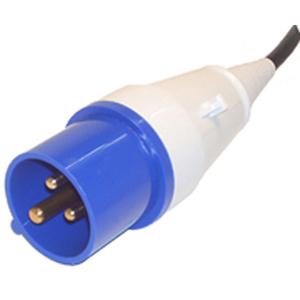
Commando
Nearly all fast chargers are untethered which means users will have to have suitable cables with them to charge their electric car. Most fast chargers have up to two sockets to enable them to charge two vehicles at the same time.
The charging speed is governed by the cars ability to handle the charge. Some cars are able to take a higher charge than others. The car will automatically work out the correct charge and draw down at that level.
All electric and hybrid vehicles in the UK will be covered by the fast charging points and cable standards.
Slow Chargers
Slow chargers are rated up to 3.6kW. Typically a full charge on a slow charger will take 6 to 8 hours.
Due to the lengthy charging times these tend to be home chargers, although they can be found at work places where an electric car is parked for most of the day. Overnight electric car charging at home can also be very cost effective, taking advantage of off-peak electricity parking. Newer electric cars can now be programmed to charge during these off peak hours.
Slow charging point standards vary but are typically Type 1 or Type 2 (shown above). Installation is normally organised when purchasing a car with the retailer who will ensure the right standard is used for your vehicle. Maximum power is dictated by the maximum amps available. A 16A circuit will allow the maximum 3.6kW, a 13A circuit less.
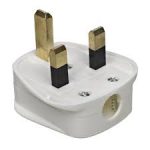
Good old 3 pin plug 240w!
It is also possible to charge your electric car using a domestic standard 3 pin socket. However, due to the long charging times (much longer) and high levels of Ampere required it is not recommended. That said, it is a valid back-up and is still supplied as standard with most EVs.
Charging Networks
There are a few charging networks that electric car users can sign up to. These offer different payment schemes and charging points. The two largest networks are;
Conclusion
The charging network with UK and Europe continues to grow rapidly. Most new electric cars and vehicles now come with satellite navigation as standard which show the charging points on it. Also make sure you check out our charge map when planning journeys.
Obviously it would be much easier if there was just one standard and one charging network, hopefully competition to be the biggest will drive expansion more quickly.
There are therefore a few different types of plugs/sockets available and your retailer will help you understand which is applicable to your electric car or hybrid vehicle.
The bottom line is, it is not too complicated and the charging network is growing quickly, just plan your journeys properly as running out of power could result in a flatbed lift to the nearest charge station!
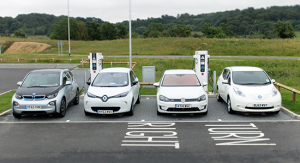


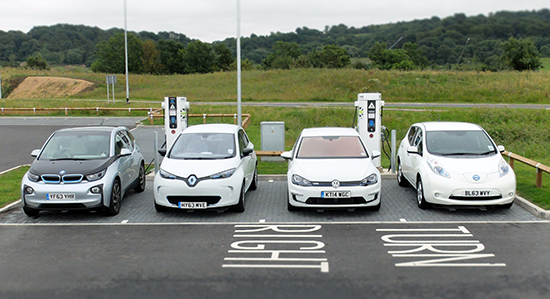
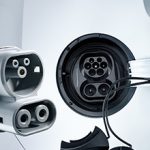

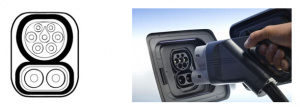


 Tesla has it’s own Supercharger network which are exclusive to Tesla cars. These Supercharger stations provide much higher powered chargers of 120kW for fast charging.
Tesla has it’s own Supercharger network which are exclusive to Tesla cars. These Supercharger stations provide much higher powered chargers of 120kW for fast charging.





Hi John
Thanks for your question. To my knowledge the B250e is fitted with an 11 kW on-board charger as standard for AC charging. Therefore, even when connected to a fast charger with a rated output above 11 kW, the Mercedes-Benz B 250e will only be able to charge at the on-board charger’s maximum level.
Hope that helps.
Rapid AC chargers use a Type 2 charging standard and provide power at up to 43kW.
Type 2 socket and plug – Just wondering -would my 2016 Mercedes B-Class B250e charge at full 43kW rate?
Thanks